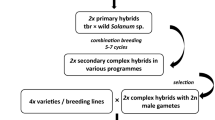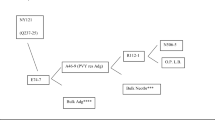Abstract
In the Dutch List of Varieties of 25 years ago many varieties occurred which are no longer grown now. By a change-over from the use of line-selection in local varieties to the application of artificial crossing, much progress was made in self-fertilizing plants (wheat, barley, oats, flax, etc.).
Great improvements were also attained in the field of grasses. Many new grass strains from Dutch breeders now figure in the List.
By paying more attention to disease resistance a number of resistant varieties have been obtained and important vistas have been opened. Increasingly and on a much larger scale than 25 years ago, use is made of the gene stock of other countries.
In sugar beet, polyploid varieties have come to the fore, while everywhere attempts are being made to raise tetraploid fodder beets. In other crops also the prospects of polyploid varieties are encouraging.
In the last 25 years many breeding establishments have been modernized. Many have glasshouses and use them to good advantage in their breeding work.
The establishment of the Foundation for Agricultural Plant Breeding (S.V.P.) rendered it possible to pay more attention to extension while private breeders are provided with good parent plants and selected hybrid populations.
The Plant Breeder's Decree became a protection of the breeder's property. As a result the number of breeders increased considerably in the last 25 years, especially those in the field of potato breeding.
Samenvatting
De rassenlijst van 25 jaren geleden bevatte tal van rassen, die thans van het toneel verdwenen zijn. Door de verdere omschakeling van lijnselectie in landrassen op het toepassen van kruising werden bij de zelfbevruchters (tarwe, gerst, haver, vlas, etc.) belangrijke vorderingen gemaakt.
Grote vooruitgang werd tevens bereikt op het gebied van de grassen. Talrijke rassen hiervan prijken thans op de rassenlijst.
Door bij het kweekwerk meer aandacht te schenken aan de ziekteresistentie zijn een aantal resistente rassen verkregen, terwijl belangrijke perspectieven geopend zijn. Veel meer dan voor 25 jaren wordt gebruik gemaakt van genenmateriaal uit andere landen.
Bij de suikerbieten zijn polyploide rassen op de voorgrond getreden, terwijl allerwegen getracht wordt tetraploide voederbietenrassen te kweken. Ook bij enkele andere gewassen zijn de vooruitzichten op polyploide rassen hoopgevend.
In de laatste 25 jaren zijn vele kweekbedrijven gemoderniseerd. Tal van kweekbedrijven beschikken over kassen en maken daarvan bij de veredeling van verschillende gewassen een zeer nuttig gebruik.
Personen met speciale kennis werden bij het kweekwerk ingeschakeld.
De totstandkoming van de S.V.P. maakte het mogelijk meer aandacht aan de voorlichting te schenken terwijl geniteurs en voorgeselecteerde populaties aan de kwekers verschaft worden.
Het tot stand komen van het Kwekersbesluit gaf een bescherming van de kwekerseigendom. Als gevolg daarvan nam het aantal kwekers in de laatste 25 jaren, speciaal op het gebied van de aardappelveredeling, aanzienlijk toe.
Similar content being viewed by others
References
Dorst, J. C., Some remarks on the breeding of field crops in the Netherlands, Euphytica 3 (1954): 212–220.
Dorst, J. C., Development and organisation of the breeding of agricultural crops in the Netherlands. Euphytica 6 (1957): 4–10.
Dorst, J. C., Een kwarteeuw plantenveredeling. In 1932–1957, Tussen ras en gewas, een serie artikelen opgesteld ter gelegenheid van het 25-jarig bestaan van de N.A.K. Wageningen, 1957, p. 121–131.
Haan, H.de, 25 jaren rassenlijst (Twenty-five years of the Dutch List of Varieties). Landbouw-kundig Tijdschrift 61 (1949): Bijlage 1–56.
Haan, H.de, Euphytica, Netherlands journal of plant breeding. Euphytica 6 (1957): 261–267.
Hogen Esch, H. J., Fifteen years activity of the Commission for the Advancement of Potato Breeding. Euphytica 2 (1953): 211–223.
Hogen Esch, H. J., De bevordering van het kweken en het onderzoek van nieuwe aardappelrassen (Advancement of potato breeding). In 1932–1957, Tussen ras en gewas. Wageningen, 1957, p. 153–159.
Thijn, G. A., The raising of first year potato seedlings in glasshouses. Euphytica 3 (1954): 140–146.
Toxopeus, H. J., Collecting cultivated potatoes in South America for potato breeding. Euphytica 5 (1956): 97–100.
Author information
Authors and Affiliations
Additional information
Adapted from an article in Dutch, published in the Memorial volume “Tussen ras en gewas” (Amidst crops and varieties) of the N.A.K. (3).
Rights and permissions
About this article
Cite this article
Dorst, J.C. A quarter of a century of plant breeding in the Netherlands. Euphytica 7, 9–20 (1958). https://doi.org/10.1007/BF00037859
Received:
Issue Date:
DOI: https://doi.org/10.1007/BF00037859




